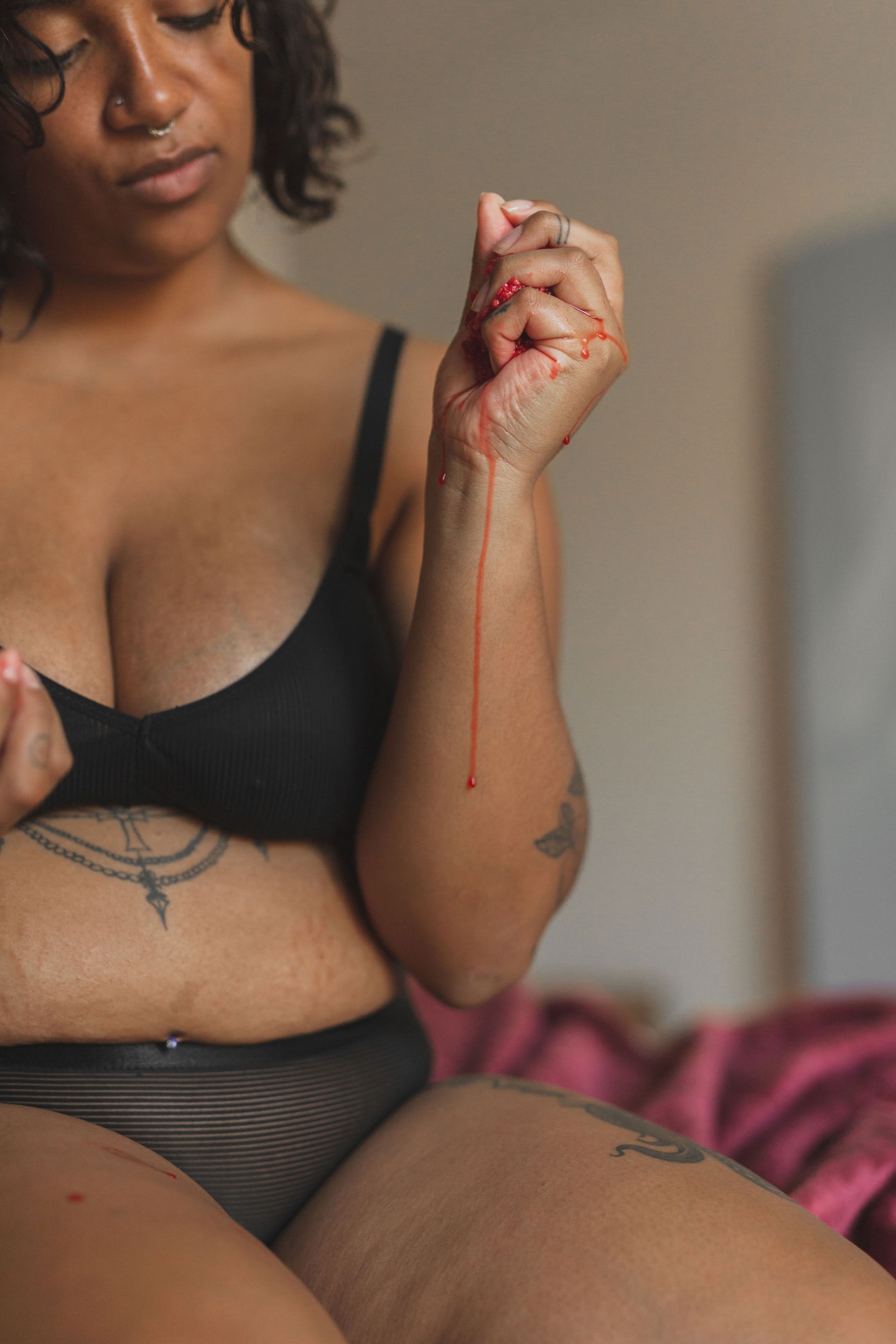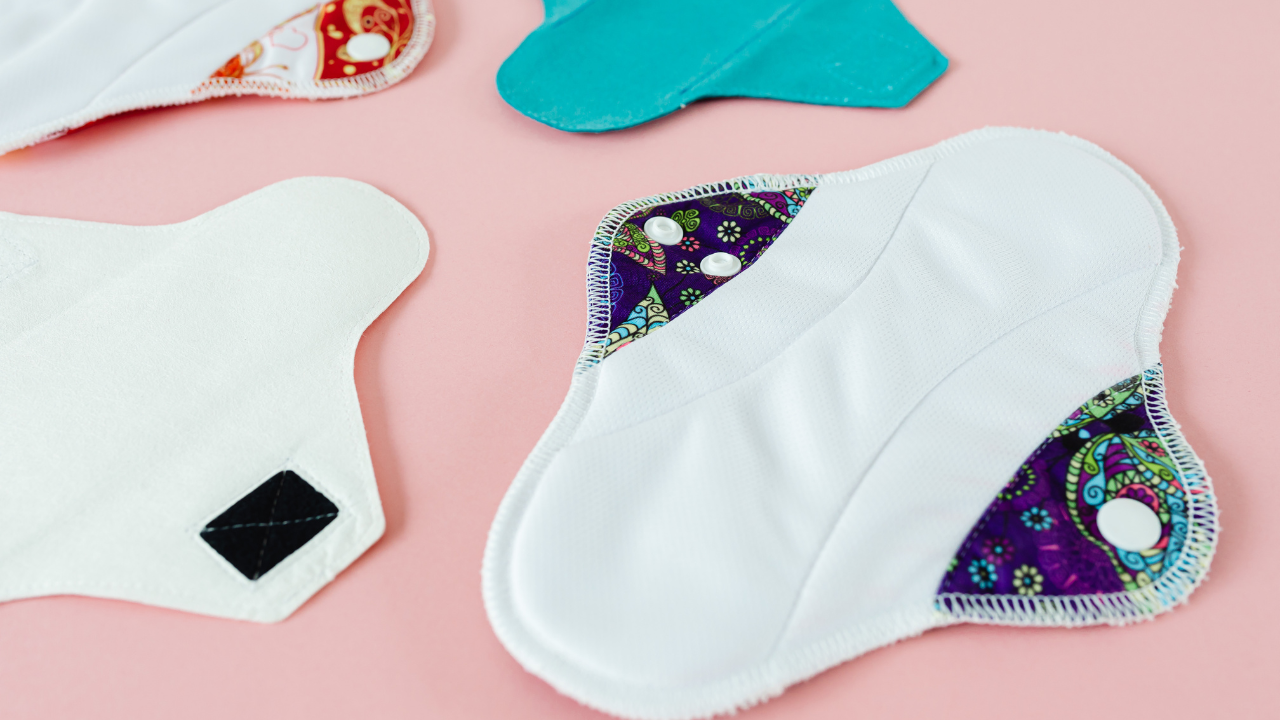
Period Positive Practices to Welcome Your Bleed
Table of Contents
Menstruation is a biological reality for nearly half the global population, yet it’s still surrounded by secrecy and shame. When looking for images to include into this article, when searching for period related images majority of what I could find is women looking like they are in complete pain and discomfort, which seems to be the mainstream idea and image of a woman on her period.
Many of us grew up hiding our bleed. This silence has lasting consequences that creates a sense of discomfort and avoidance surrounding the topic.
The period positive movement is a global effort to change this. It was started by activists and educators who wanted to end menstrual stigma and ensure that every person who bleeds has access to education, products, and dignity.
In this article, we’ll look at how the movement began, what menstrual literacy really means, and how we can help build a world where periods are no longer hidden but fully supported.
What is Period Positivity?

Period positivity is a cultural and educational movement that actively challenges the shame and misinformation that have surrounded periods for centuries. Period positivity insists that menstruation is a normal, healthy biological process, one that should be spoken about openly and integrated into public life without stigma.
The phrase “Period Positive” was coined by Chella Quint, a Sheffield-based comedian, researcher, and menstrual health educator. In 2006, she launched the Period Positive Campaign. Quint’s aim was to dismantle period taboos in schools and workplaces by giving people tools and spaces to discuss menstruation without embarrassment. Her resources included lesson plans and community-based initiatives that positioned menstrual literacy as part of health education and gender equality.
From these grassroots beginnings, the movement gained global momentum. Hashtags like #PeriodPositive, #FreePeriods, and #EndPeriodPoverty helped spread the conversation on Instagram and Twitter, making periods a mainstream social justice issue rather than a private burden. Countries such as Scotland, which in 2020 became the first in the world to provide free period products nationwide, drew inspiration from the broader push toward period positivity.
The Philosophy of Period Positivity

At its heart, period positivity is about menstrual literacy, the right to understand your cycle and how menstruation impacts health and daily life. Instead of treating periods as a monthly problem to endure, the philosophy reframes them as a vital part of human biology that deserves respect and honest conversation.
This approach recognizes that menstrual education is a form of social justice. When girls and women lack access to accurate information or affordable products, they are denied opportunities for full participation in society. UNESCO estimates that 1 in 10 girls in sub-Saharan Africa misses school during menstruation due to lack of access to sanitary products and safe spaces. In India, cultural stigma still forces 1 in 5 girls to drop out of school once they reach menarch (the occurence of your first period). Period positivity addresses these inequalities by insisting that menstrual health is inseparable from gender equity and human rights.
Equally important, the movement challenges the cultural messages that frame menstruation as dirty or something to be concealed. Advertising campaigns historically taught women to hide their periods, think blue liquid in pad commercials or slogans about “freshness.”
How to Be Period Positive
1. Normalize Your Language
Language shapes culture. When we say “Aunt Flo,” “the curse,” or “that time of the month,” we reinforce the idea that menstruation is something to joke about or hide. Using the word “period” directly is a political act. It signals that menstruation belongs in the open, not tucked away in code.
Start at home. Speak plainly with children so that they grow up seeing periods as normal. Use clear words with partners so that menstrual needs don’t get brushed aside or minimized. And in workplaces, direct language makes it easier to advocate for accommodations, such as flexible scheduling or access to products. Changing the words we use is the first step in shifting the culture around us.
2. Try Free Bleeding

Free bleeding reclaims the choice of how to manage menstruation. Instead of automatically reaching for tampons or pads, some women choose to bleed without internal products, sometimes at home, sometimes in public as a way of breaking the association between menstruation and shame.
Our Free Bleed® Blankets or absorbent Nookees period panties make it possible to let blood flow naturally without discomfort or fear of staining. For many, free bleeding is about making a statement that menstruation doesn’t need to be hidden to be acceptable.
3. Advocate for Free Period Products
Imagine entering a public restroom (in a first world country) and finding no toilet paper. The outrage would be immediate. Yet for decades, menstrual products, which are just as essential, have been excluded from that same standard. Period positivity argues that pads and tampons should be as accessible as soap or toilet paper, because managing menstruation is not optional.
Being period positive means pushing for change in schools, workplaces, gyms, and community centers. Advocate for free dispensers in restrooms, and support legislation that makes products affordable or free.
4. Explore Period Sex Without Shame
Sex during menstruation is one of the strongest ways to dismantle menstrual taboos. It challenges the idea that desire should shut down simply because blood is present. For many women, orgasms during their period bring relief from cramps because of the release of endorphins and oxytocin, and the increased pelvic blood flow often heightens sensitivity.
Making period sex comfortable only requires simple adjustments. A dark towel or washable throw, or a Free Bleed® Blanket makes cleanup easy. Some couples experiment with menstrual discs, which sit behind the pubic bone and allow penetration with minimal mess, while others find pleasure in exploring slower, more tender positions that feel supportive when the body is already working hard.
5. Support Menstruation Education
Too often, schools reduce menstruation to a single awkward session that barely covers the mechanics of bleeding, leaving young people unprepared for the realities that come with it. Period positivity insists that education should extend far beyond this. It includes teaching cycle awareness as well as how those shifts influence energy, mood, and sexual desire.
It also means openly discussing product options, from pads and tampons to cups and period underwear, so women can make informed choices rather than relying on whatever is most marketed.
6. Experiment with Different Menstrual Products

For decades, pads and tampons have dominated the narrative around period management, but they represent only a fraction of what is available. Exploring alternatives is one of the most empowering aspects of becoming period positive, because it shifts the focus from what companies have told us we need to what actually feels best for our own bodies.
This exploration also sparks bigger questions, like why should menstruation be a one-size-fits-all industry? Why shouldn’t comfort, sustainability, and personal preference drive the market? Period positivity thrives in these choices, reminding us that menstruation is also about finding what makes us feel supported and at home in our bleeding bodies.
7. Promote Period Positive Workplaces
Workplaces have been designed as if bodies run on one flat rhythm, when in reality half of the workforce moves through hormonal tides every month. A period positive workplace recognizes this and makes space for it. In Japan, menstrual leave policies have existed since 1947, though cultural stigma still discourages use. More recently, Spain became the first European country to legislate paid menstrual leave in 2023.
These examples show how systemic change is possible, but progress often begins with smaller shifts inside individual companies. A workplace that allows remote work during heavy bleeding days, or designates quiet rest areas where employees can step away when pain peaks, acknowledges menstruation as a legitimate factor in productivity and wellbeing.
8. Join or Start a Period Positive Campaign
Grassroots activism has always driven menstrual reform. Chella Quint’s first zines and school workshops in Sheffield were scrappy, handmade efforts, yet they seeded a global movement. Today, campaigns like #FreePeriods in the UK or Pad Man initiatives in India (if you do not know this story, I reccomend you check it out, it is very inspiring and heartwarming) have shown how local action sparks international conversation.
Joining an existing project can mean fundraising for pads and tampons at a women’s shelter, hosting a school workshop on cycle awareness, or distributing period underwear in refugee camps where disposables are scarce. If no campaign exists in your community, starting small still matters.
9. Share Your Period Story Publicly

Menstrual storytelling takes the private and makes it unavoidably public. When women speak about their experiences, they puncture centuries of enforced silence. In 2015, musician Kiran Gandhi famously ran the London Marathon free bleeding, refusing to hide her period during one of the most visible athletic events in the world. Her act ignited global conversation and inspired others to share their own stories online.
10. Treat Menstrual Health as Whole Health
To be period positive is to treat menstrual patterns as vital signs, just as important as blood pressure or heart rate. A cycle that suddenly shortens or lengthens, bleeding that becomes excessively heavy, or cramps that leave someone immobilized can point toward conditions like endometriosis, PCOS, thyroid imbalance, or anemia.
Yet these symptoms are often dismissed by doctors as “normal period pain.” Research shows that women with endometriosis frequently endure an average of seven years before receiving a diagnosis. This gap exists because menstrual health has not been prioritized in medical training or healthcare systems.
How to Have a Period Positive Workplace
The workplace is often where menstrual stigma shows up most sharply. Employees push through cramps in silence or take sick days without disclosing the real reason. The result is lost productivity and a culture where menstruation is still treated as something unprofessional or shameful. Creating a period positive workplace signals dignity, equality, and recognition that menstrual health is as legitimate as any other health need.
In one progressive office I worked for years ago, a “zen room” was introduced that was quiet, comfortable, and available for anyone experiencing menstrual pain or fatigue. We also had an employee that was allowed to pump her breasts in the zen room, which i find amazing.
Policies and Practices
Practical policies are where the philosophy of period positivity takes root. Providing free pads and tampons in every restroom is a basic starting point. Just as toilet paper and soap are standard, menstrual products must be treated as essential rather than optional extras.
Beyond supplies, flexibility matters. Offering the option to work from home during the heaviest days of a cycle, or allowing flexible start times when fatigue or cramps are severe, acknowledges the lived realities of menstruation without forcing employees to choose between health and job security.
These practices create trust. When women know they are supported, they are more likely to stay engaged and productive.
Conclusion
In 2025, something remarkable is happening where periods are stepping out of the shadows. What used to be spoken about in hushed tones is now showing up in headlines and everyday conversations. Period positivity has become a cultural shift gathering speed across the globe.
But the real revolution doesn’t only happen in parliament halls or HR offices. It begins in the body. It begins in the way you greet your bleed each month, with shame or with welcome, with secrecy or with honesty. Every time you choose to call it what it is, every time you reach for a product that actually feels good for your body, every time you allow yourself to rest instead of pushing through, you are participating in this shift.
I invite you to take one practice from this article and make it yours. Try free bleeding one night at home. Speak plainly about your period at work. These are small acts, but they are radical ones, because they rewrite how we relate to our blood.

